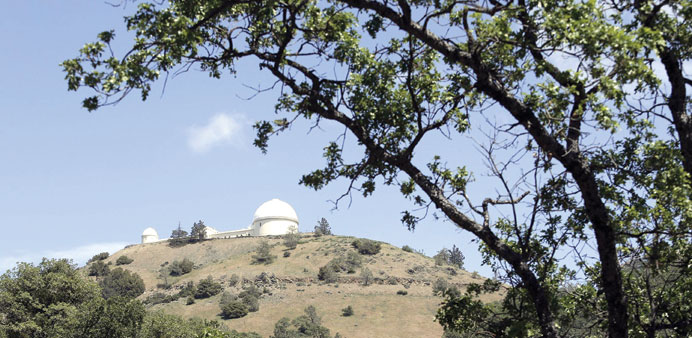High in the hills of East San Jose, a world-renowned institution is marking its 125th year of pioneering explorations of the night sky.
And to think the plans to build Lick Observatory almost lost out to a giant pyramid.
Instead, the science community in 1888 got a state-of-the-art, 36-inch Giant Refractor telescope that still is the second largest of its kind in the world. The observatory’s telescopes are used today to test the latest technology, conduct cutting-edge research and continue the search for exoplanets, which are those outside our solar system.
But this scientific hotbed was built more for reasons of ego than astronomy: James Lick, the richest man in California, was out to spend his fortune on a large memorial, according to historians. He considered a greater-than-Giza-sized pyramid for downtown San Francisco or super-size statues of his family that could have been seen by ships at sea.
In the end, he bankrolled the first mountaintop observatory.
The Victorian-era gift of $700,000 from the eccentric California entrepreneur would be worth more than $1.2bn today, according to a ‘Forbes’ magazine article based on a 2008 paper by Alexander MacDonald, an economist for Nasa.
As the son of a small-town cabinetmaker in Pennsylvania, Lick earned his first fortune building fine pianos — first in New York City and then in Argentina. Years later, when he took his wealth back home to marry the mother of his son, she spurned him. So he spent another stint in South America, then journeyed to California and arrived just before the Sutter’s Creek gold strike.
While others headed for the hills, Lick staked his claims on real estate in San Francisco, Santa Clara and Lake Tahoe, to amass a richer fortune. He even owned Catalina Island at one point.
When Lick commissioned the observatory’s construction, every other similar facility in the world was inside cities’ limits. But streetlights and smog were a problem even in the 19th century. Mount Hamilton, therefore, was an attractive site.
As the years passed, Lick’s savvy choice of location has allowed the observatory’s hilltop telescopes to employ adaptive optics, the special “glasses” that clear the blurry vision caused by the atmosphere when light streams down from distant stars. These customised instruments help astronomers search the night sky for dimly lit stars that are otherwise outshone by their brighter neighbours.
Although the road to the summit is switchbacked and long, Lick Observatory is still easier for scientists to reach than telescopes in Chile or Hawaii.
“We’re the first test bed,” said Elinor Gates, senior astronomer.
Recently, a radical new superconducting sensor for astronomical cameras got a trial run on the 3m Shane telescope on the San Jose summit. ARCONS (ARray Camera for Optical to Near-IR Spectrophotometry) translates incoming light so fast it can make movies of the Crab Pulsar, a neutron star that spins 33 times per second, said Ben Mazin, a University of California, Santa Barbara, physics professor and one of the camera’s developers. “It’s really valuable to have the 3m telescope at the Lick Observatory so close,” Mazin said.
Even Nasa headed for the local hills to test an infrared camera on the observatory’s 1m Nickel telescope before sending the technology aloft.
The optical technology has down-to-earth applications, too, Gates said. The instruments that enable astronomers to see distant stars can also help doctors look at cells in the back of the eye.
Although nine telescopes have a home on Mount Hamilton, only four get put to work on a regular basis: the Shane, the 1m Nickel, the automated KAIT, which looks for supernovae, and the 36-inch Giant Refractor. Of these, the Shane reflector is the workhorse for which scientists regularly book research time, Gates said.
The showboat of the telescopes is the Giant Refractor, used to give visitors their “big wow” views of Jupiter or Saturn on clear, dark nights, Gates said. The astronomical relic weighs 25,000 pounds and dwarfs everything else under the steel dome of the observatory. Yet, the 57-foot-long telescope tube is so finely balanced, Gates can grab the arms-width steering wheel and move the instrument by hand to get a better view of the next nebulae.
The observatory itself reflects Lick’s early life as the son of a woodworker. The walls are built with locally milled redwood, and the floor under the Giant Refractor is planked with concentric circles of maple and mahogany. Hydraulic pumps built in 1881 still smoothly raise the floor — as high as 16 feet — when the telescope is angled too high overhead for an astronomer to reach the eyepiece on their own.
In the main building, rooms with extra-high ceilings boast original oak doors that swing on hinges with intricate designs. There’s even a walk-through safe between the observatory and the director’s office, built so astronomers could remove and rescue the valuable 36-inch lenses from the telescope in case of wildfires.
More than 150,000 glass photographic plates in small, white envelopes overflow the drawers of file cabinets wedged inside the dry, dusty archives. An adjoining area is stacked floor to ceiling, with laboratory books filled with decades of astronomers’ penciled observations.
There are also shelves of reduction books, the meticulous notations of “the lady computers” — the women who were not allowed to be astronomers but did the painstaking work of analysing all the information collected.
The 125th anniversary marks the official consignment of the Lick Observatory to the University of California on June 1, 1888. Unfortunately, for its benefactor, he never got to look through the eyepiece of the Great Refractor. Lick died almost 12 years before the telescope was completed — and a small brass plaque commemorates his final resting place under the finely milled floorboards of his observatory. — San Jose Mercury News/MCT



